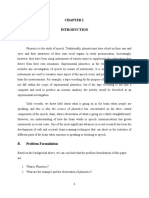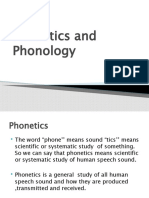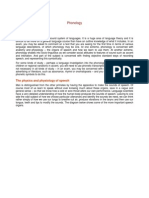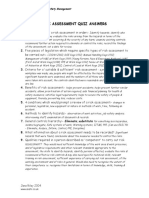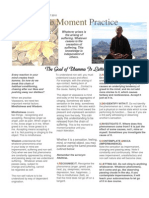Lecture 1 - Questions For Revision and Discussion
Lecture 1 - Questions For Revision and Discussion
Uploaded by
nguyentragiang2001bnCopyright:
Available Formats
Lecture 1 - Questions For Revision and Discussion
Lecture 1 - Questions For Revision and Discussion
Uploaded by
nguyentragiang2001bnOriginal Title
Copyright
Available Formats
Share this document
Did you find this document useful?
Is this content inappropriate?
Copyright:
Available Formats
Lecture 1 - Questions For Revision and Discussion
Lecture 1 - Questions For Revision and Discussion
Uploaded by
nguyentragiang2001bnCopyright:
Available Formats
QUESTIONS FOR REVISION AND DISCUSSION
SPEECH AND SPEECH SOUNDS
1. Phonetics and phonology
a. What is phonetics?
Phonetics is “the science which studies the characteristics of human sound-
making, especially those sounds used
in speech, and provides methods for their description, classification and
transcription
b. What are the main branches of phonetics?
The three main branches of phonetics are:
▪ Articulatory phonetics: focuses on how speech sounds are produced by
articulators;
▪ Acoustic phonetics: focuses on how speech sounds are transmitted;
▪ Auditory phonetics: focuses on how the ear translates sound waves into
electrical impulses to the brain and how the brain perceives these as speech
sounds.
c. What is phonology?
Phonology is the study of “the sound systems of languages”
d. What is the difference between segmental phonology and suprasegmental
phonology?
Segmental phonology deals with individual sounds (segments) and linear
strings of sounds
suprasegmental phonology analyses features that extend over more than one
segment
e. What is the relationship between phonetics and phonology?
Phonology is often defined as the cognitive aspects of sound structures and
sound patterns
phonetics is understood to be the physical implementation of these structures
and patterns.
Phonology uses the methods of social science to study speech sounds as
cognitive or psychological entities, which are abstract
symbols that are discrete and categorical
Phonetics uses the methods of natural science to study speech sounds as
physical entities, which are concrete and thus exist in actual space and time that
are gradient and continuous.
f. Find some information about the applications of phonetics and phonology on
the Internet.
Neurology can use information about the processing of phonology and phonetics
in the brain for the diagnosis and treatment of patients with brain lesions.
Phonetics are the foundation for treating the whole range of speech problems,
ranging from children with speech impediments or slow acquisition of sounds to
aphasia patients (such as stroke victims) and people with speaking problems due
to hearing impairments
2. The human speech production system
a. Name the three subsystems of the human speech production system.
The human speech production system can be divided into three
subsystems:
▪ The subglottal vocal tract (the respiratory system)
▪ The larynx (the phonatory system)
▪ The supra-laryngeal vocal tract (the articulatory system)
b. Name the major speech organs in each subsystem.
-The subglottal vocal tract consists of the lungs, the bronchial tubes, and the
trachea (windpipe).
-The larynx: vocal folds
- The supra-laryngeal (or supra-glottal) vocal tract is above the larynx and
consists of three resonating cavities:
▪ The nasal cavity (the nose)
▪ The oral cavity (the mouth)
▪ The pharyngeal cavity (the pharynx)
c. What is pulmonic egressive airstream?
All English sounds are produced with a pulmonic egressive airstream. This
movement describes an outgoing airstream produced by the lungs and is
regarded as the only airstream mechanism that uses lung air.
d. Briefly describe six modes of phonation. Which ones are used linguistically;
which ones are used paralinguistically/extralinguistically in English?
-Voiced: The vocal folds are brought lightly together and vibrate as the air
passes over them.
-Voiceless: The glottis is wide open for the air to escape.
-Whisper: The vocal folds are brought close enough together to make the
continuous airflow through them turbulent, either through a gap left at the back
or through a narrowed glottis.
-Creaky voice: The front part of the glottis vibrates, at a much lower frequency
than in normal voicing, while the back part is pressed more tightly together
-Breathy voice: A combination of whisper and voiced mechanisms
-Glottal stop/closure: The vocal folds make a complete obstruction to the
airstream.
e. What is the difference between active articulators and passive articulators?
▪ Active articulators: lower lip, tongue front, tongue body, and tongue root;
▪ Passive articulators: upper lip, upper teeth, alveolar ridge, hard palate, soft
palate, uvula,and pharyngeal wall
f. Draw a mid-sagittal cross-section of the head with labels for speech organs.
3. Transcribing sounds
a. What are the problems of the modern English spelling system?
• One letter can represent more than one sound;
E.g. <c> represents [k] (cat, cut, etc.) or [s] (city, cell, etc.)
• One sound can be represented by more than one letter;
E.g. [ʌ] is represented by <o> (son, mom, month, etc.) or <u> (cut, shut, tub,
etc.)
• There are a lot of silent letters.
E.g. knight, name, doubt, debt, psychology, etc
b. What are the principles on which the IPA is based?
▪ The symbols are universal;
▪ The symbols are unambiguous
c. How is phonemic transcription different from phonetic transcription?
Phonemic transcription represents the abstract sound system of a language,
while phonetic transcription represents the actual pronunciation
E.g. Phonemic transcription: /kæt/, /kɪt/, /kɒt/, etc.
Phonetic transcription: [kæt], [kʰætʰ], [kʰæˀt̚ ], [kʰæʔ], etc
d. How is broad transcription different from narrow transcription?
Broad transcription uses the simplest possible set of symbols, while narrow
transcription provides more phonetic details.
E.g. /hiːt/ is narrower than /hit/; [kʰæˀt̚ ] is narrower than [kæt]
4. The phoneme and the allophone
a. Briefly explain these concepts: phoneme, allophone, and phone.
b. What is a minimal pair? Give examples.
A minimal pair is a pair of words that differ in only a single sound in the same
position
E.g: [pɒt] and [dɒt] are a minimal pair
→ [p] and [d] are contrastive and occur in overlapping distribution
c. Provide examples of contrastive and non-contrastive sounds in English.
d. How is overlapping distribution different from complementary distribution?
Give examples.
e. What is free variation? Give examples.
f. What is positional neutralization? Give examples.
You might also like
- Catcher in The Rye AnnotationsDocument21 pagesCatcher in The Rye Annotationsapi-611717663No ratings yet
- ENG507 Short NotesDocument15 pagesENG507 Short Notesmalik.imaanNo ratings yet
- A Course in Phonetics by Peter Ladefoged PDFDocument15 pagesA Course in Phonetics by Peter Ladefoged PDFPralay SutradharNo ratings yet
- Fujitsu Dps-450sb A 450w So-319 ReportDocument1 pageFujitsu Dps-450sb A 450w So-319 ReportJohn MachoNo ratings yet
- The Mystery of the Seven Vowels: In Theory and PracticeFrom EverandThe Mystery of the Seven Vowels: In Theory and PracticeRating: 4 out of 5 stars4/5 (9)
- Resume FonologiDocument24 pagesResume FonologiEndang Tri RahayuNo ratings yet
- Phonetics and PhonologyDocument3 pagesPhonetics and PhonologySad CypressNo ratings yet
- English PhoneticsDocument36 pagesEnglish PhoneticsNorbinkoNotorickoNo ratings yet
- PhoneticsDocument17 pagesPhoneticsMohammed DjadaniNo ratings yet
- Lectures On English Phonetics and PhonologyDocument92 pagesLectures On English Phonetics and PhonologyCẩm LinhNo ratings yet
- Phonetics Notes 23Document17 pagesPhonetics Notes 23Micaela MoralesNo ratings yet
- Phonetics Lecture 1Document33 pagesPhonetics Lecture 1Mosa NgomaneNo ratings yet
- Phonetics 1Document31 pagesPhonetics 1minhngocchuyenvantbNo ratings yet
- PhoneticsDocument12 pagesPhoneticsBenzzRaeyeldieNo ratings yet
- Sofl Library Answers To PhoneticsDocument32 pagesSofl Library Answers To Phoneticsnguyenhoaianhthu0% (1)
- دكتور هاشم المحاضرة الاولىDocument6 pagesدكتور هاشم المحاضرة الاولىanmar ahmedNo ratings yet
- Linguistic Complete Notes Semester 3Document78 pagesLinguistic Complete Notes Semester 3Mr Qamar (Qamar Jamil)No ratings yet
- Phonetic and Phonology": Miranti Widyasari Tatebale 17091102047Document12 pagesPhonetic and Phonology": Miranti Widyasari Tatebale 17091102047MIRANTI WIDYASARI TATEBALENo ratings yet
- Chapter 1: Speech Mechanism: Introduction To PhonologyDocument19 pagesChapter 1: Speech Mechanism: Introduction To PhonologySanaNo ratings yet
- Answers To PhoneticsDocument30 pagesAnswers To PhoneticsHuyền Lâm91% (22)
- Linguistics - Unit 3Document5 pagesLinguistics - Unit 3Appas SahaNo ratings yet
- 4 Phonetics: Speech OrgansDocument8 pages4 Phonetics: Speech OrgansLorz CatalinaNo ratings yet
- English Phonetics and Phonology - Doc NOTESDocument49 pagesEnglish Phonetics and Phonology - Doc NOTESbadak8375% (4)
- PhoneticsDocument56 pagesPhoneticsAnushka Chittora100% (1)
- Paper LinguisticsDocument10 pagesPaper Linguisticsaika.kadyralievaNo ratings yet
- Phonetics I - Cartilla 2021Document15 pagesPhonetics I - Cartilla 2021te.amo.6938No ratings yet
- Phonetics and Phonology S4 EnsDocument6 pagesPhonetics and Phonology S4 Ensezzaidihajar87No ratings yet
- The Word Phonetics' Defined.: Chapter Three Understanding PhoneticsDocument16 pagesThe Word Phonetics' Defined.: Chapter Three Understanding PhoneticsJoyNo ratings yet
- Phonetics and PhonologyDocument22 pagesPhonetics and PhonologyQamar Khokhar0% (1)
- Phonetics and Phonology 1Document12 pagesPhonetics and Phonology 1Mohamed bouizyNo ratings yet
- Phonology PDFDocument18 pagesPhonology PDFSivakumarThangavelNo ratings yet
- 语言学3Document45 pages语言学3mochen439No ratings yet
- I Year B. Tech. Lab NotesDocument39 pagesI Year B. Tech. Lab Notesbalajichakilam2012No ratings yet
- Phonetics and PhonologyDocument41 pagesPhonetics and PhonologyAli Mahdi100% (1)
- Ibn Tofail University LevelDocument23 pagesIbn Tofail University LevelImad Es SaouabiNo ratings yet
- TSLB 3043 - Overview Lecture 1Document21 pagesTSLB 3043 - Overview Lecture 1Rubbitharani NadesonNo ratings yet
- 1.1 & 1.2 Phonetics and Ipa (Introduction)Document16 pages1.1 & 1.2 Phonetics and Ipa (Introduction)Kristel Joy Adorador CarmonaNo ratings yet
- LIN (Seng Ra)Document1 pageLIN (Seng Ra)Vichet EMNo ratings yet
- What Is Definition of PhonologyDocument12 pagesWhat Is Definition of PhonologyIsriani IshakNo ratings yet
- Introduction To Phonetics Handout (Enla 216)Document57 pagesIntroduction To Phonetics Handout (Enla 216)muhammedteshome88No ratings yet
- Practical Phonetics Lecture 1Document12 pagesPractical Phonetics Lecture 1Katherine MondaNo ratings yet
- PhoneticsDocument9 pagesPhoneticsNguyễn Đình ĐạtNo ratings yet
- Intro To Phonetics & PhonologyDocument20 pagesIntro To Phonetics & Phonologyzainsaghir7576No ratings yet
- Tema 9Document7 pagesTema 9Juan Martinez AguilarNo ratings yet
- Phonetics and Phonology #Cotha - 77Document28 pagesPhonetics and Phonology #Cotha - 77marufhaque.427No ratings yet
- Phonetics and Phonology Grup 18Document18 pagesPhonetics and Phonology Grup 18Cholif Lespa TrionoNo ratings yet
- Lecture 3 Articulatory PhoneticsDocument29 pagesLecture 3 Articulatory Phoneticsdavegreenwood100% (1)
- Phonetics PDFDocument41 pagesPhonetics PDFClaudia CojocaruNo ratings yet
- Phonology in English Language TeachingDocument15 pagesPhonology in English Language TeachingAlfa AlfaNo ratings yet
- Introduction and Production of Speech SoundDocument31 pagesIntroduction and Production of Speech SoundNguyệt MaiNo ratings yet
- Teknologi System Komputer: (Year)Document12 pagesTeknologi System Komputer: (Year)Pley DungsNo ratings yet
- Unit 8 The English Phonological System (Ii)Document17 pagesUnit 8 The English Phonological System (Ii)Miriam Reinoso SánchezNo ratings yet
- Phonetics and PhonologyDocument21 pagesPhonetics and PhonologyNasir Hasan AshikNo ratings yet
- MariaFitri Phonetic&Phonology Sem.4Document3 pagesMariaFitri Phonetic&Phonology Sem.417. Maria Fitri Nur ArafahNo ratings yet
- Unit 7 The English Phonological System (Document13 pagesUnit 7 The English Phonological System (Miriam Reinoso SánchezNo ratings yet
- TOPIC 8. The Phonological System of The English LanguageDocument9 pagesTOPIC 8. The Phonological System of The English LanguageCristinaNo ratings yet
- 1st - Sem - English - Unit - 2 B EdDocument27 pages1st - Sem - English - Unit - 2 B EdBrilliant Brainz MalayalamNo ratings yet
- English Phonetics and PhonologyDocument86 pagesEnglish Phonetics and PhonologyAdamsLouisPhan79% (14)
- Introduction To LinguisticsDocument3 pagesIntroduction To Linguisticsistri sehunNo ratings yet
- Microbial Ecology and Starter Culture Technology in Coffee ProcessingDocument15 pagesMicrobial Ecology and Starter Culture Technology in Coffee ProcessingLael IsazaNo ratings yet
- Entry To Practice CompetenciesDocument20 pagesEntry To Practice CompetenciesmydewyboyNo ratings yet
- PE 4 - Lesson No. 1 Introduction On PE 4 Recreation and Leisure Activities (Module 1)Document24 pagesPE 4 - Lesson No. 1 Introduction On PE 4 Recreation and Leisure Activities (Module 1)Rea Angela DealcaNo ratings yet
- Pasewark Work Family ConflictDocument20 pagesPasewark Work Family ConflictAma de HaniNo ratings yet
- User Manual NapoliDocument44 pagesUser Manual NapoliAhmed saNo ratings yet
- Types and Remedies of Cracks in ConcreteDocument4 pagesTypes and Remedies of Cracks in ConcreteWeconstructit WciNo ratings yet
- Poster Scientifique 800x1200mm - Innra70ansDocument2 pagesPoster Scientifique 800x1200mm - Innra70ansfeghbalibNo ratings yet
- New Oxidation Process For Production of Terephthalic Acid From P XyleneDocument5 pagesNew Oxidation Process For Production of Terephthalic Acid From P XyleneJOSEPH HERBERT MABEL100% (1)
- Takreem Khan 20181-23585Document3 pagesTakreem Khan 20181-23585Takreem khanNo ratings yet
- Specification: F.V/Time 5min 10MIN 15MIN 30MIN 1HR 2HR 3HR 4HR 5HR 8HR 10HR 20HR 9.60V 10.0V 10.2V 10.5V 10.8V 11.1VDocument2 pagesSpecification: F.V/Time 5min 10MIN 15MIN 30MIN 1HR 2HR 3HR 4HR 5HR 8HR 10HR 20HR 9.60V 10.0V 10.2V 10.5V 10.8V 11.1VGeorgeNo ratings yet
- SERVICE MANUAL For Aqv09ewanDocument83 pagesSERVICE MANUAL For Aqv09ewangcharalNo ratings yet
- The Other Wes Moore - Chapter 3 - Ezra KeelenDocument2 pagesThe Other Wes Moore - Chapter 3 - Ezra KeelenYoungJ DetroitNo ratings yet
- Manual de Partes CX24Document6 pagesManual de Partes CX24Axel BetancourtNo ratings yet
- Module 3 - The Helping Relationship Part 2Document22 pagesModule 3 - The Helping Relationship Part 2Rotchell Abila PelayoNo ratings yet
- 803371.EX - in - Optical Smoke Detector Ex I IQ8Quad FM Without IsolatorDocument1 page803371.EX - in - Optical Smoke Detector Ex I IQ8Quad FM Without IsolatorFatima Zahra ArdadNo ratings yet
- Biology Unit3Document16 pagesBiology Unit3Logan ParkisonNo ratings yet
- College of Arts & Sciences: Google Meet Link - 1 Semester AY 2022-2023Document2 pagesCollege of Arts & Sciences: Google Meet Link - 1 Semester AY 2022-2023TrixieNo ratings yet
- Module 1 Understanding Culture Society and PoliticsDocument41 pagesModule 1 Understanding Culture Society and Politicsbldryn lnNo ratings yet
- RISK ASSESSMENT QUIZ ANSWERS (Confer)Document1 pageRISK ASSESSMENT QUIZ ANSWERS (Confer)Roh Young songNo ratings yet
- Moment To Moment PracticeDocument1 pageMoment To Moment PracticeDoug KelshawNo ratings yet
- Crim311 Week 14 1ST Sem 22-23Document16 pagesCrim311 Week 14 1ST Sem 22-23Eduardo FriasNo ratings yet
- Please Review Assignees of Consent Form and IDocument3 pagesPlease Review Assignees of Consent Form and Idfolorunsho50No ratings yet
- Acme Laboratories Ltd. - Unsolicited-PtdDocument13 pagesAcme Laboratories Ltd. - Unsolicited-PtdnasirNo ratings yet
- Mark Scheme: Assessment Unit A2 1Document10 pagesMark Scheme: Assessment Unit A2 1chowdhuryNo ratings yet
- Group - 6 Home&Travel InsuranceDocument11 pagesGroup - 6 Home&Travel Insurance28-RPavan raj. BNo ratings yet
- Aircraft-Maintenance-Reviewer (Fuel Metering System)Document15 pagesAircraft-Maintenance-Reviewer (Fuel Metering System)edwinNo ratings yet
- Chapter 58A-5 Assisted Living FacilitiesDocument36 pagesChapter 58A-5 Assisted Living Facilitiesstring44No ratings yet
- Legislation and Regulation For E-Commerce in KenyaDocument2 pagesLegislation and Regulation For E-Commerce in KenyaKena MutisyaNo ratings yet













